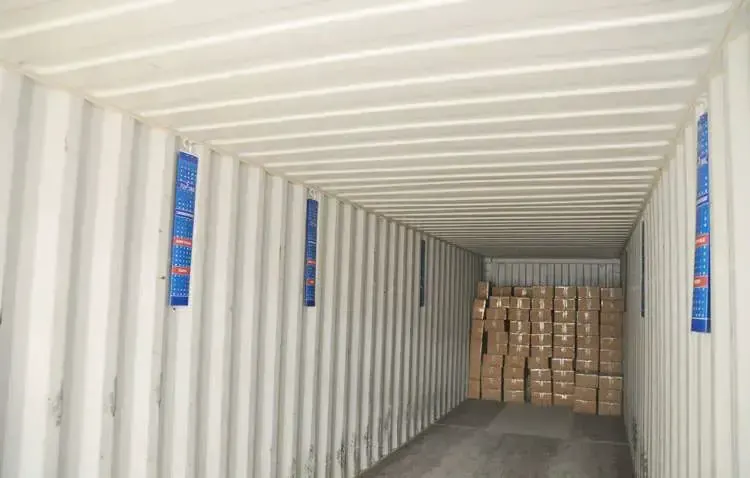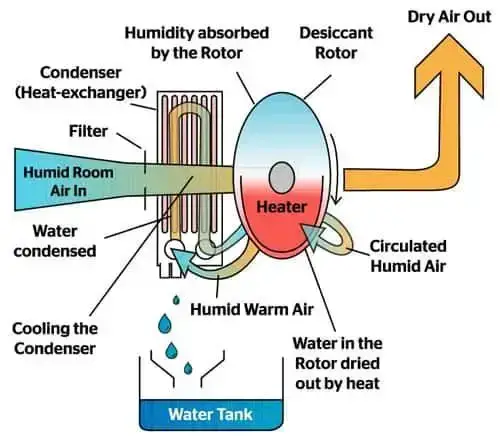If you’re building a shipping container home, then you must learn how to stop condensation in your container home. Shipping containers are essential for transporting goods across long distances, but they often face challenges related to moisture control.
Without proper precautionary measures, moisture can accumulate inside the containers, leading to significant damages to your valuable cargo. This is where dehumidifiers for shipping containers come in.
A dehumidifier is a device designed to reduce and maintain the humidity levels within a confined space, such as a shipping container.
It removes excess moisture from the air, preventing the formation of mold, mildew, corrosion, and other moisture-related issues that can compromise the integrity of your cargo.
One of the major challenges in shipping container transportation is that they are susceptible to temperature and humidity fluctuations.
Extreme weather conditions during transit, condensation from temperature changes, and even humidity from the loading and unloading process can contribute to moisture buildup.
This poses a serious threat to delicate products, especially electronics, textiles, perishable goods, and any items sensitive to moisture.
Proper humidity control is crucial for protecting your cargo from these potential damages. By implementing dehumidifiers in shipping containers, you can maintain optimal humidity levels, ensuring the safety and quality of your goods throughout the entire transportation process.
Whether you are shipping items locally or internationally, investing in a high-quality dehumidifier provides an extra layer of protection and peace of mind.
Table of Contents
Understanding Moisture Control in Shipping Containers
Moisture control in shipping containers is crucial for the preservation of cargo and maintaining its quality. Failure to adequately control moisture levels can lead to significant damage and losses.
In this section, we will explore the various factors contributing to moisture accumulation, the impact of moisture on cargo, and the applicable regulations and guidelines for moisture control in shipping.
Read More on Shipping Container Homes In Oklahoma: Stylish and Sustainable
A. Factors Contributing to Moisture Accumulation in Shipping Containers
There are several factors that contribute to the accumulation of moisture in shipping containers:
- Shipping container conditions: The condition of the shipping vessel, such as leaks or inadequate ventilation, can result in the ingress of moisture into the container.
- Climate and weather variations during transit: Changes in temperature and humidity levels during the journey can lead to condensation and moisture buildup inside the container.
- Types of cargo and their moisture content: Certain cargoes, such as produce or goods with high moisture content, can release moisture into the container during transit.
B. Impact of Moisture on Cargo Quality and Condition
Excess moisture in shipping containers can have detrimental effects on the quality and condition of the cargo:
- Potential damage caused by excess moisture: Moisture can promote the growth of mold, fungi, and bacteria, leading to spoilage, degradation, and contamination of the cargo.
- Relationship between temperature, humidity, and cargo preservation: Maintaining optimal temperature and humidity levels is crucial for preserving the quality and shelf life of the cargo, preventing spoilage, and minimizing the risk of deterioration.
Read More on How Much Is A Container Home in Florida? Your Ultimate Guide
C. Applicable Regulations and Guidelines for Moisture Control in Shipping
Various regulations and guidelines have been established to ensure proper moisture control in shipping containers:
- Standard requirements for packaging and ventilation: These regulations specify the minimum standards for packaging and ventilation to control moisture and prevent damage to the cargo.
- International standards for moisture control systems: International organizations have developed standards for moisture control systems, ensuring their effectiveness and safety during transportation.
- Industry best practices: Many industry organizations and associations provide guidelines and best practices for moisture control in shipping containers.
Types of Dehumidification Systems for Shipping Containers
A. Desiccant Dehumidifiers

To point out, desiccant dehumidifiers are a popular choice for controlling moisture in shipping containers. These systems use a desiccant material, such as silica gel or activated alumina, to absorb moisture from the air.
1. Explanation of Desiccant Dehumidification Process
In summary, desiccant dehumidifiers work by passing air through a rotating desiccant wheel or drum. Whenever the air passes through the desiccant, the moisture in the air is adsorbed onto the surface of the desiccant material.
Read More on Shipping Container Homes in Oregon: Sustainability And Style
2. Benefits and Limitations of Desiccant Dehumidifiers
Desiccant dehumidifiers have several benefits, including their ability to operate at lower temperatures and lower energy consumption compared to refrigeration-based systems. They are also effective in drying out extremely wet or humid environments.
However, desiccant dehumidifiers may not be suitable for all situations. They typically require a power source, such as electricity, and need periodic replacement of the desiccant material.
Additionally, desiccant systems may not be as effective in environments with low humidity levels.
Read More on Shipping Container Homes in Connecticut: Build Your Dream Home
3. Cases Where Desiccant Dehumidifiers Are the Best Fit
- Highly humid environments
- Extremely wet or flooded shipping containers
- Cold storage or temperature-controlled containers
B. Refrigeration-based Dehumidifiers

Refrigeration-based dehumidifiers, also known as condensation dehumidifiers, are another type of dehumidification system used in shipping containers. These systems work by cooling the air to condense moisture, which is then collected and drained.
1. Explanation of Refrigeration-based Dehumidification Process
Refrigeration-based dehumidifiers operate by drawing warm, humid air into the system through an opening.
The air is then cooled using a refrigeration circuit, causing the moisture in the air to condense and form water droplets. The condensed water is collected and drained out of the system.
Read More on Shipping Container Homes in Nevada: Innovative Architecture
2. Benefits and Limitations of Refrigeration-based Dehumidifiers
In general, refrigeration-based dehumidifiers have the advantage of being able to maintain desired humidity levels consistently. As a result, they are suitable for controlling moisture in a wide range of temperature and humidity conditions.
However, refrigeration-based dehumidifiers require a power source and may not be as effective in extremely low temperatures. They also produce noise and generate heat during operation.
3. Cases Where Refrigeration-based Dehumidifiers Are Suitable
- Temperature-sensitive cargo
- Constant humidity control
- Low humidity environments
Factors to Consider When Choosing a Dehumidifier
A. Container Size and Volume
When it comes to selecting a dehumidifier for your shipping container, one of the most important factors to consider is the size and volume of the container. In sum, it is crucial to choose an appropriately-sized dehumidifier to ensure optimal moisture control.
Recommended dehumidifier capacity based on container dimensions:
- For small containers (less than 20 feet), a dehumidifier with a capacity of 20 pints per day is recommended.
- For medium containers (20-40 feet), a dehumidifier with a capacity of 25-30 pints per day is suitable.
- Finally, for large containers (greater than 40 feet), a dehumidifier with a capacity of 35-45 pints per day is recommended.
B. Cargo Type and Sensitivity
Important to realize that not all cargo items have the same moisture tolerance level. And so it is important to understand the moisture sensitivity of different cargo types and select a dehumidifier tailored to their specific requirements.
Selecting dehumidifiers tailored to specific cargo requirements:
- For moisture-sensitive cargo such as electronics or delicate goods, a dehumidifier with advanced humidity control features and precise moisture level adjustments is recommended.
- For less sensitive cargo such as non-perishable items, a standard dehumidifier with adjustable humidity settings may suffice.
C. Climate and Shipping Conditions
Without doubt, the climate and shipping conditions play a crucial role in the effectiveness of a dehumidifier.
For this reason, it is important to choose a dehumidifier that can adapt to various climates and weather conditions, ensuring consistent moisture control.
Considerations for long-haul versus short-haul shipping:
- For long-haul shipping, a dehumidifier with durable construction and high performance in extreme temperature conditions is recommended.
- For short-haul shipping, a portable dehumidifier with ease of installation and maintenance may be more suitable. Simple desiccant
Read More on Shipping Container Home In Louisiana: How To Build One
Installation and Use of Dehumidifiers in Shipping Containers
As I have mentioned, installing a dehumidifier in a shipping container is essential for maintaining proper moisture levels and safeguarding your cargo.
Here, we explore the optimal placement and positioning of dehumidifiers, operating and monitoring tips, as well as alternative solutions for humidity control.
A. Placement and Positioning of Dehumidifiers
- Optimal locations to ensure even airflow and moisture extraction: Proper placement of dehumidifiers is crucial to achieve uniform airflow and effective moisture extraction. It is recommended to position the dehumidifier in the center of the container, ensuring sufficient space around it for air circulation.
- Avoiding blockage and optimizing dehumidifier performance: Be mindful of any obstructions that could block the airflow, such as cargo or other items. Keep the area surrounding the dehumidifier clear to maximize its performance and efficiency.
B. Operating and Monitoring Dehumidifiers
- Setting appropriate humidity levels based on cargo requirements: Different cargos have varying moisture sensitivity. Therefore, ensure you set the appropriate humidity levels on your dehumidifier according to the specific requirements of your cargo. This will prevent any damage caused by excessive moisture.
- Regular maintenance and servicing of dehumidifiers: To maintain optimal performance, it is vital to regularly clean and service your dehumidifiers. Follow the manufacturer’s instructions for maintenance and replace filters when needed.
C. Alternative Solutions for Humidity Control in Containers
- Passive methods such as desiccants and moisture absorbers: In addition to using dehumidifiers, you may also consider utilizing passive methods like desiccant packs or moisture absorbers to help control humidity levels within the container.
- Integrating container modifications for improved ventilation: Modifying your shipping container to improve ventilation can also be an effective solution. Installing additional vents or exhaust fans can enhance airflow and aid in moisture control.
Read More: How To Build A Wall Inside A Shipping Container
Case Studies and Success Stories of Dehumidifiers for Shipping Containers
The implementation of dehumidifiers in the shipping container industry has led to numerous success stories and remarkable transformations.
Let’s take a closer look at some real-world scenarios where dehumidification systems have proven to be game-changers.
Case Study 1: Reducing Moisture-Related Damages
In a recent project, DHL integrated a high-capacity dehumidifier in their shipping container to transport delicate electronic equipment across the ocean.
By maintaining the humidity levels at an optimal range, they successfully prevented moisture-related damages such as rust, mold, and corrosion.
This not only saved them substantial costs in replacing damaged equipment but also ensured timely delivery to their clients.
Read More on The Incredible History Of Shipping Container That Will Amaze You
Case Study 2: Preserving Food Quality
A large-scale food exporter, Statista, faced significant challenges in preserving the quality of their perishable goods during overseas transportation.
By installing dehumidification systems in their shipping containers, they were able to maintain ideal humidity levels, preventing spoilage and extending the shelf life of their products.
As a result, they witnessed a decrease in product loss and a boost in customer satisfaction, ultimately increasing their market share.
Case Study 3: Enhancing Product Reliability
In collaboration with a leading automotive manufacturer, Munters implemented their cutting-edge dehumidifiers within shipping containers transporting vehicle parts.
By eliminating excess moisture, they successfully mitigated the risk of moisture-induced defects, ensuring that the delivered parts maintained their performance and reliability.
This partnership led to an increase in customer trust, repeat orders, and ultimately, higher profitability for the automotive manufacturer.
These case studies highlight the tangible benefits of utilizing dehumidifiers in shipping containers. However, it is essential to acknowledge the challenges faced and the lessons learned throughout these implementations.
Benefits of Dehumidifiers for Shipping Containers
- Protection against moisture-related damages, such as rust, mold, and corrosion
- Preservation of product quality and extended shelf life
- Prevention of moisture-induced defects, ensuring product reliability
Challenges of Dehumidifiers for Shipping Containers
- Choosing the right dehumidification system for specific shipping container requirements
- Ensuring proper installation and maintenance of the dehumidifier
- Optimizing energy consumption while maintaining effective moisture control
Through these case studies and real-life experiences, it is evident that the implementation of dehumidifiers in shipping containers has revolutionized the industry, providing invaluable benefits and overcoming significant challenges.
When considering moisture control in shipping containers, it is paramount to learn from these success stories and make informed decisions to achieve optimal results.
Read More on An Exclusive Look At The Different Types Of Shipping Containers
Conclusion
A. Recap of the importance of dehumidifiers for shipping containers
- Dehumidifiers play a crucial role in maintaining optimal moisture levels in shipping containers.
- Excess moisture can lead to condensation, mold growth, and damage to cargo.
- By using dehumidifiers, you can ensure the integrity of your goods during transportation.
B. Key recommendations for effective moisture control
- Choose a dehumidification system that is suitable for the size and conditions of your shipping container.
- Regularly monitor humidity levels inside the container to prevent excess moisture accumulation.
- Implement proper ventilation and insulation to enhance moisture control.
C. Future innovations and technologies in container humidity regulation
- Advancements in dehumidifier technology are continuously being made to improve efficiency and effectiveness.
- New solutions, such as smart dehumidifiers with automated controls, are emerging to simplify the monitoring and regulation process.
- Stay updated with advancements in container humidity regulation to ensure the best protection for your cargo.
By understanding the importance of dehumidifiers for shipping containers and implementing effective moisture control measures, you can safeguard your goods and prevent costly damages.
Remember to choose the right dehumidification system, monitor humidity levels, and stay informed about the latest innovations in container humidity regulation.
Read More on Container Pools Canada: Revolutionizing Swimming Pool Design
